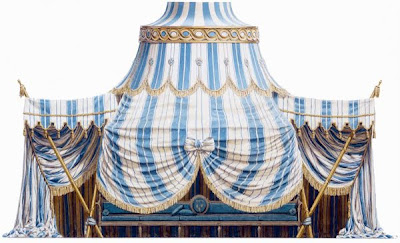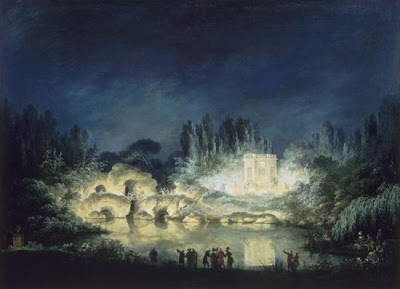Thursday, July 7, 2011
Garden Tents
One of the most evocative symbols of summer is the garden tent, so it's the perfect subject for July's first post.
In the late eighteenth century, Europeans considered tents the most characteristic of Oriental structures and erected them prolifically in their gardens, indiscriminately labeling them as Tartar, Turkish, Siamese or Chinese. There was a kernel of truth in this notion since nomadic tents are indeed the origin of the Chinese pagoda's characteristically concave, upturned roof—though it is highly doubtful that any European gardener of the period knew this.
As picturesque as they were inexpensive, tents became a staple of Anglo-Chinese folly gardens and a number of them, such as the Tartar Tent at the Parc Monceau in Paris (above) were even constructed of permanent materials. Sheathed in trompe l'œil tole-work (painted tin sheet-metal), this tent was actually an open-air alcove and part of a wing added to the main pavilion; dense plantings to either side hid the connecting passageways from view. Built circa 1775, it was also the first of its kind, inspiring similar tole-work tents at the Désert de Retz and at Haga and Drottningholm in Sweden.
The Parc Monceau, the Duc de Chartres' folly garden, which today is a Parisian city park, also featured this extraordinary draped canvas tent (above); nearby was a stand with turbaned lackeys offering camel rides (below).
These engraved scenes of Monceau by Carmontelle, the park's designer, are among our favorites: they carefully record the slightly mad clutter of this Ancien Régime Disneyland and are peopled by elaborately clothed and bewigged visitors, perfectly capturing the atmosphere of slightly absurd refinement that reigned in French folly gardens. Just how self-consciously aburdist or surreal Monceau actually was is in fact quite difficult to judge; consider, for example, that no structure was more characteristic of the countryside of the period than a windmill just like the folly depicted in the lower view—it would be comparable to building a suburban split-level in a landscape garden today.
Ephemeral garden tents became extremely fashionable at Versailles during the reign of Louis XVI, as their ease of construction, inherent theatricality and low cost made them the perfect foil for the numerous, equally extravagant fêtes hosted by Marie-Antoinette at Trianon. Elaborate garden parties, often spanning a week's festivities, were an ancient royal tradition and were first mounted at Versailles by Louis XIV in the late 1600s. In contrast to the baroque pomp of the Sun King, Marie-Antoinette transformed the landscape gardens of Trianon into a rustic, illuminated wonderland for her famed evening garden parties. (Below, the Belvedere during one of these "illuminations.")
Popular rumor was such that after the Parisian mob stormed Versailles in 1789, among the first demands of the deputies of the Third Estate was to examine the Queen’s garden tents, which they believed fashioned of precious fabrics encrusted with gold and silver. The reality, retrieved from the store rooms of the Menus plaisirs, was more worthy of the stage than royalty: painted canvases hung with pasteboard decorations.
Subscribe to:
Post Comments (Atom)





There is also a Turkish Tent at Drottningholm, the Swedish summer palace that I was fortunate to visit a few years ago. Of a similar form with stripe decoration, it is wood rather than metal, if I remember correctly. In any case, these drawings are magnificent!
ReplyDeleteIt makes sense that ephemeral garden tents would become fashionable in the Versailles gardens during the reigns of Louis XIV and XVI. After all, home owners want ease of construction, low costs and glamour, including royalty.
ReplyDeleteBut "ephemeral" is the key word here. Assuming the tents didn't last forever, how do we know what late 17th -> mid 18th century parties looked like. Paintings? inventories? courtiers' diaries?
"What is left behind" is a good question, Hels--and one we always address in the prefaces to our books. Basically, outside the royal sphere, it's a question of luck--someone drew it, engraved it or painted it, and that representation also survived. Inventories, correspondence and diaries can also yield invaluable information, but you need a decent visual record to start.
ReplyDeleteThe flip side of the coin is that in some periods (early Louis XIV) there was also an active supression of information re: state-sponsored architecture. A good topic for a later post!